‘In memory there is defiance’: inside the V&A exhibition exploring Palestinian textile and embroidery as an act of resistance
Amid the ongoing devastation in Gaza, a new exhibition at V&A Dundee explores Palestinian textiles, embroidery and garments as a means to tell personal and communal histories
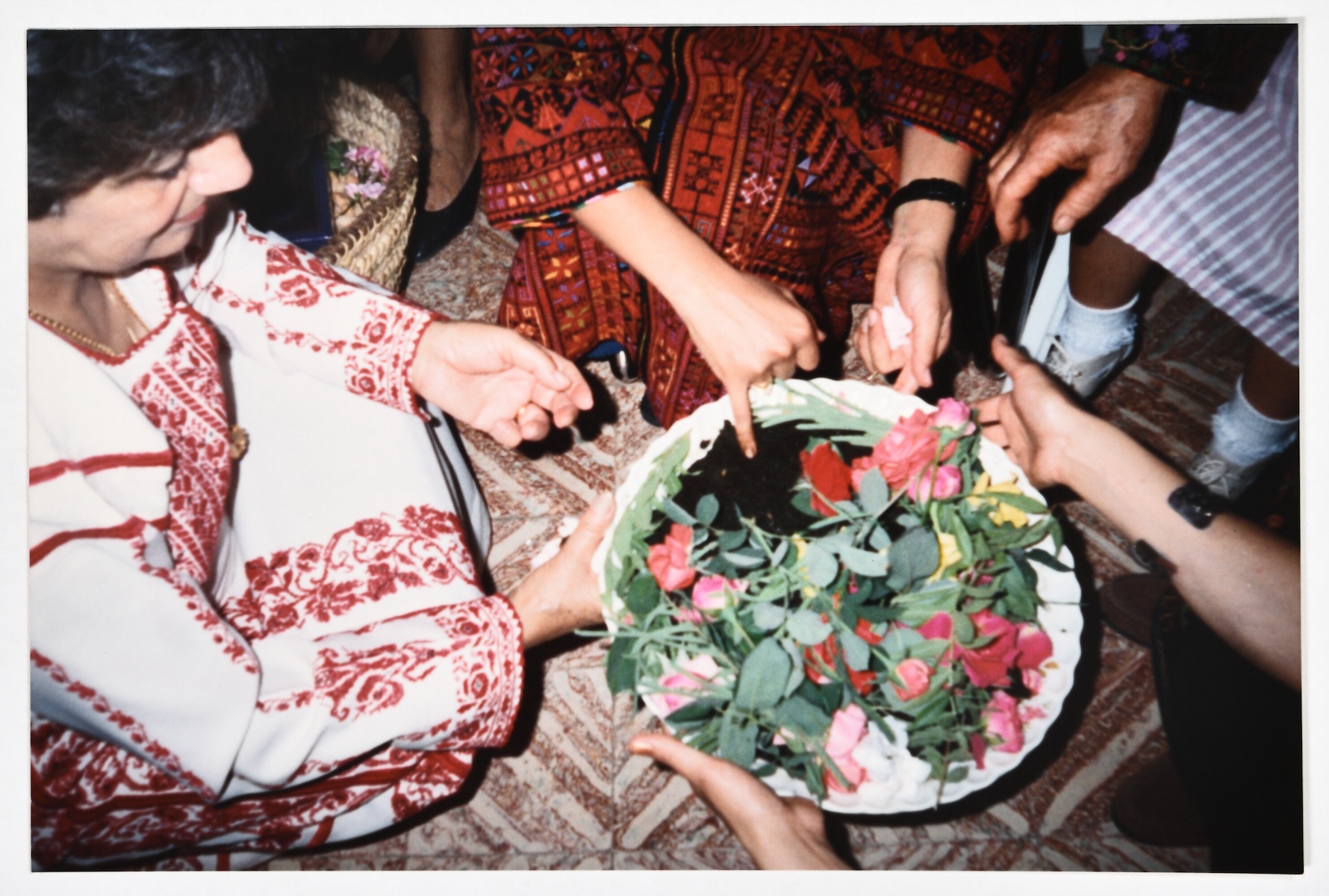
Amid Israel’s military occupation of Palestine, the starvation and displacement of millions of Palestinians, and the deliberate targeting of Palestinian heritage, ‘Thread Memory: Embroidery from Palestine’ at V&A Dundee brings together a vital and urgent display of hundreds of garments and textiles, personal photographs, and rare artefacts that span nearly 150 years of Palestinian history: from the late 19th century through to the British Mandate, the Nakba of 1948, the First and Second Intifadas, into today’s catastrophic siege on Gaza. The messaging behind the exhibition is clear: to bear witness to the resilience of the Palestinian people through the clothes and garments that tell stories and hold memories, and embroidery that resists erasure.
More than a textile exhibition, the works on display are preserved from the ongoing destruction of cultural heritage sites – including museums and libraries – in the region. According to the Palestinian Ministry of Tourism and Antiquities-Palestine, more than 200 culturally significant sites have been damaged or destroyed since October 2023 alone, while Unesco has called for their protection. Among institutions destroyed are the Central Archives in Gaza, the Rashad Shawa Cultural Center, and the Beit Hanoun Public Library. The exhibition at V&A Dundee is presented in collaboration with the Palestinian Museum in Birzeit in the West Bank and Hayy Jameel, in Jeddah, Saudi Arabia. It is free to the public, and it could not come at a more critical time.
‘Thread Memory: Embroidery from Palestine’ at V&A Dundee
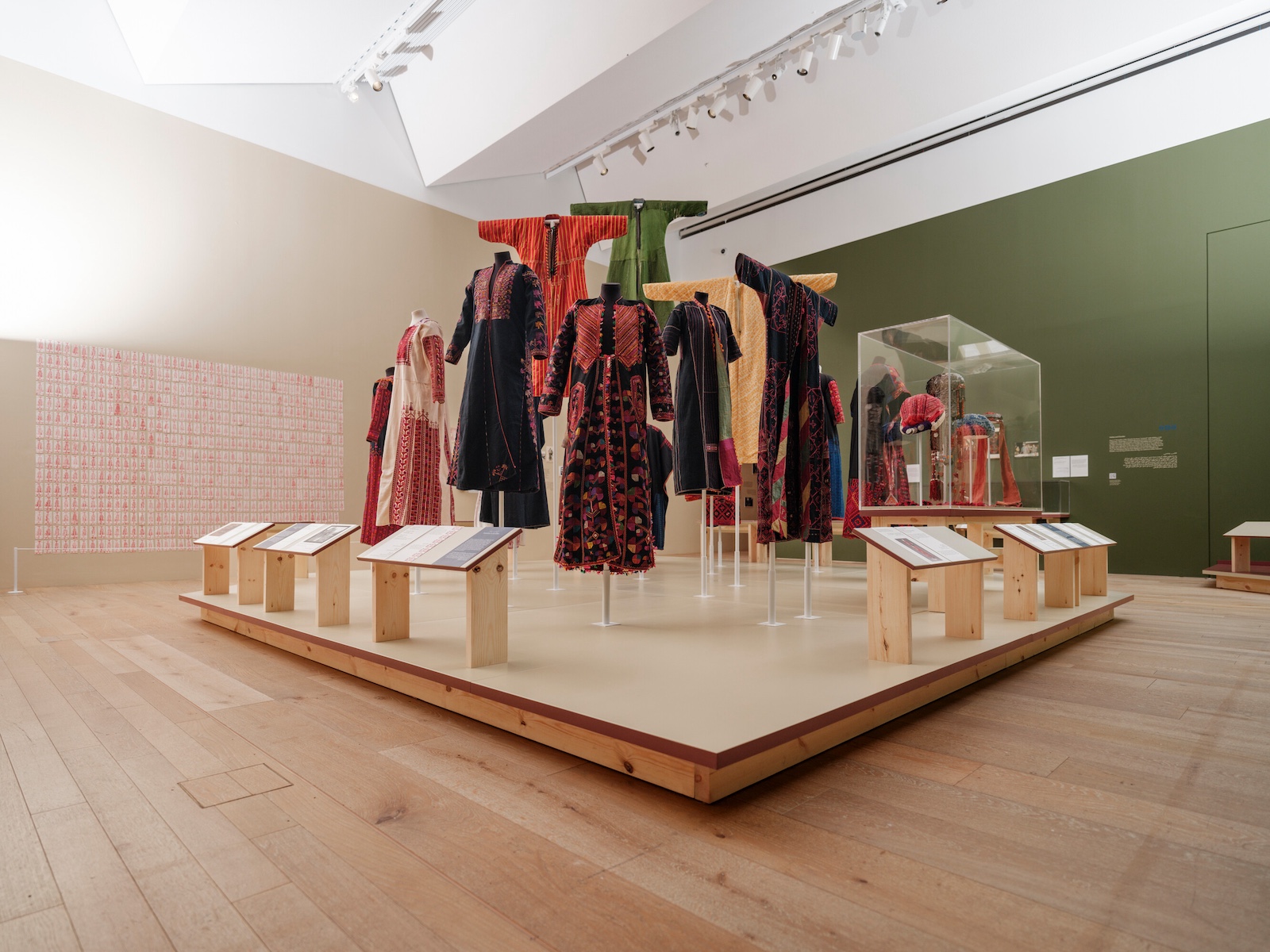
The exhibition collates garments and fabrics from the late 19th century until the present day
‘It’s an ever-evolving project and opportunity to keep telling stories in different ways through different objects,’ says curator Rachel Dedman. ‘We’re addressing the genocide in Gaza and the brutal occupation of Palestine, but more broadly, I think, glimpsing the ways in which grief is written into objects, the way clothing was connected to love or motherhood. These are very simple and quiet ways in which garments can speak to us.’ In Palestine, tatreez (embroidery) is not merely decorative; it is a language. Passed down through generations of women, it is a vernacular of identity, belonging, and resistance, stitched into dresses, jackets, and shawls to tell stories and preserve cultural memory. Each village (many of which have since been destroyed and erased from the map) once had its own distinct patterns, colours, and motifs; visual dialects that carried personal and communal histories.
A single dress might record a woman’s marital status, the number of her children, her region, or losses that she carried. The exhibition documents garments made during the British Mandate era in Palestine (1920-1948), a period of colonial rule that played a significant role in shaping modern Palestinian identity, and in laying the groundwork for the structural violence that endures today. Tellingly, many garments from this time include linings made from British imported tartans and textiles, remnants of a colonial power whose policies of partition and displacement continue to reverberate through Palestinian life. And yet, even in these materials, Palestinian women found ways to assert their heritage and quietly subvert domination.
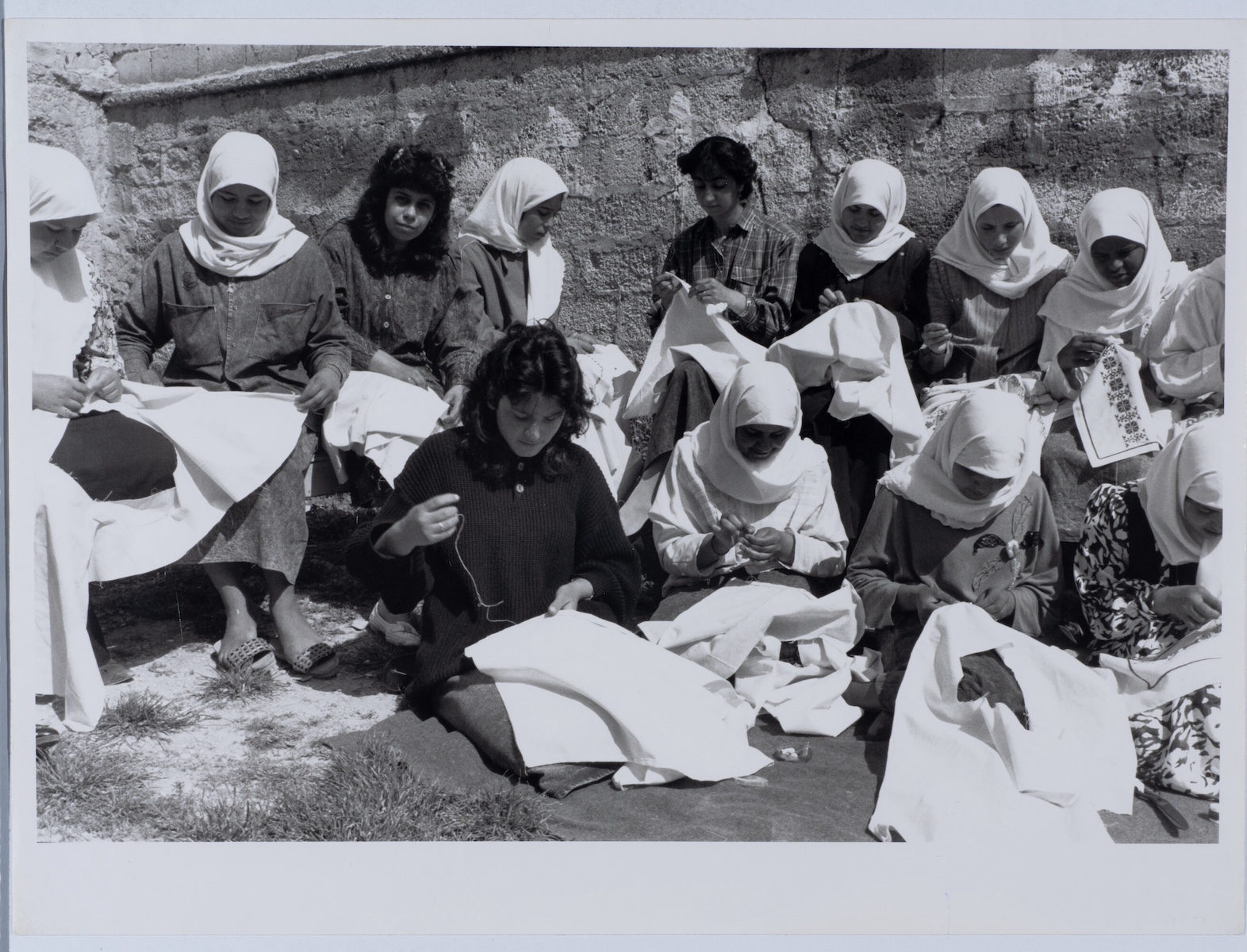
Female members of the Qalandiya Camp Women Handicraft Cooperative Society participating in one of the Society's projects, 1958
As violence escalated during the First Intifada in the late 1980s, embroidery became an act of resistance. One particularly striking dress on display was likely stitched in secret by candlelight, using synthetic threads dyed in the banned colours of the Palestinian flag. To wear it in public was to risk arrest. The act of creating it was a form of slow resistance, or sumud – the Arabic word for steadfastness in the face of oppression. Colours carry deep symbolic weight: magenta, for example, is tied to Gaza and believed to offer protection; red, most often used in wedding garments, signifies joy; while indigo blue conveys mourning and loss.
After the Nakba in 1948, with communities uprooted and homes destroyed, many of the garments now on display became living archives; in many cases, they are the only surviving evidence of a destroyed village. One such garment is a 1920s wedding dress from Beit Nabala, a village wiped from the map in 1948. The dress is plain and modest, apart from red embroidery that climbs up each side. The body of the dress is patched, and clearly worn, with fingerprint marks and a nursing slit, which was later sewn shut and the bodice has been widened over time to fit multiple women as it passed down generations of women. There is only one known photograph of Beit Nabala, displayed beside the dress. Its faded pink threads and scorched fabric bear the brutal signature of war. ‘Palestinians have faced targeted destruction, which is part of the cultural genocide strategy, and keeping these objects safe, and keeping them visible, is the priority,’ Dedman says. ‘They should continue to tell their stories.’
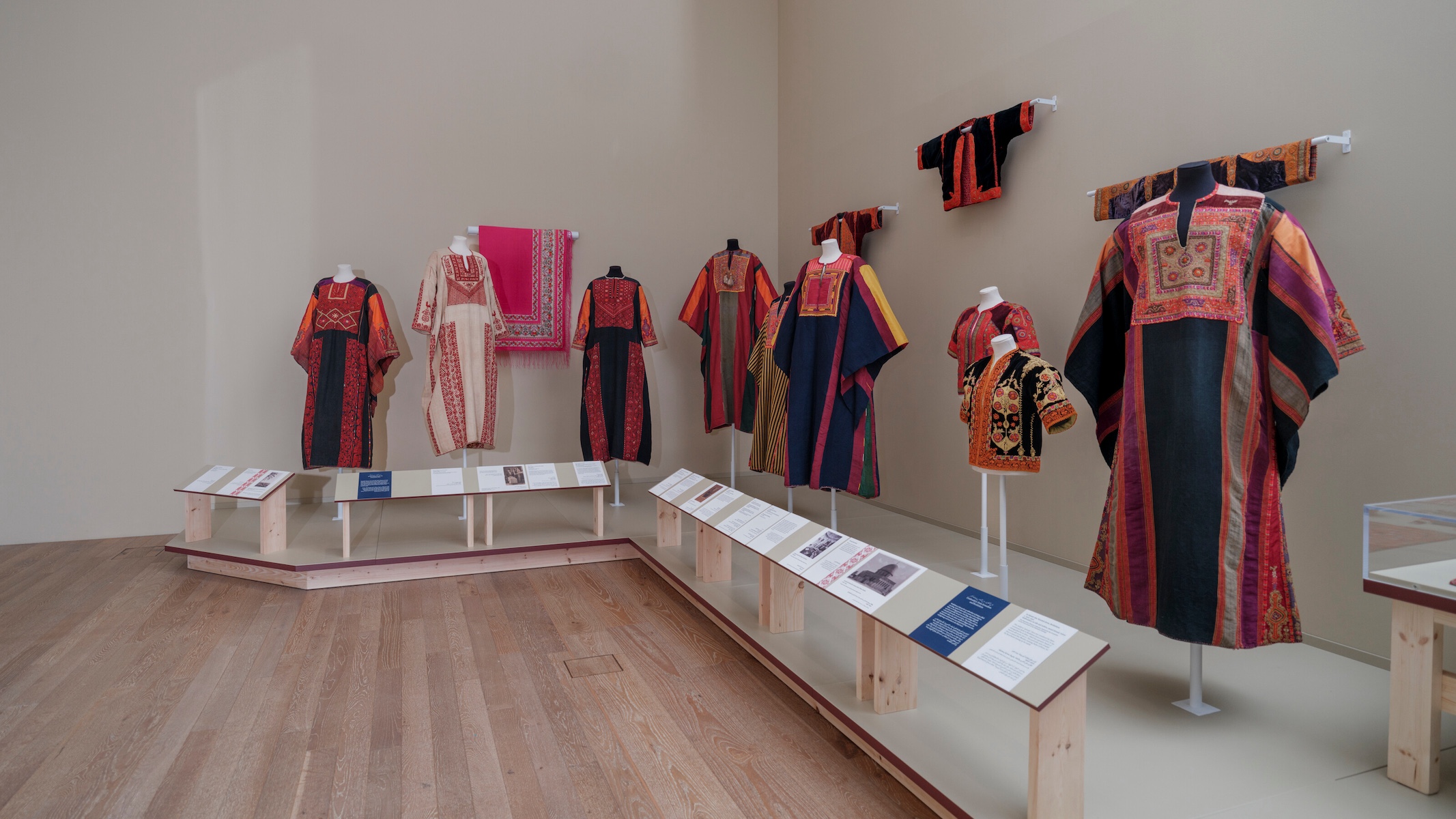
The exhibition is put on alongside Art Jameel, the Palestinian Museum and V&A South Kensington
Over 500 villages were erased during the Nakba. And today, the destruction continues as museums, libraries, mosques, alongside 90 per cent of Gaza’s schools have been damaged or destroyed, and hospitals, homes and cafés in Gaza are continually bombed, their resources, archives and belongings turning to ash. One of the institutions lost was the Rafah Museum, which was bombed and flattened by an Israeli airstrike in 2023. During the blast, a child’s embroidered dress was blown onto a neighbouring rooftop, where it lay for a year, exposed to sun, wind, and rain, until it was salvaged and eventually loaned to the exhibition by the Palestinian Museum, and now it's on display at ‘Thread Memory’. Along one gallery wall, the scale of loss becomes achingly clear in an installation by Scottish-Palestinian artist Leena Nammari. The wall is covered in 626 porcelain tiles, each one stamped with the cypress tree (a symbol of endurance) and each marking one of the 626 Palestinian villages destroyed since 1948.
Receive our daily digest of inspiration, escapism and design stories from around the world direct to your inbox.
The final gallery shifts from traditional garments to the cutting edge of Palestinian fashion today. Here, a new generation of designers wrestles with what it means to inherit a tradition under threat. Designer Zeid Hijazi has created a tartan-tatreez hybrid look inspired by a Tunisian sci-fi film, Bedouin Hacker. His sharp-shouldered silhouette evokes punk defiance and technological resistance, reflective of a metaphorical hacker cracking through the occupation’s system. The look honours Scottish tartan while celebrating Palestinian embroidery as a form of code; a language embedded in material, passed on and hacked into new forms. Also on display is Look 5 from Palestinian Central Saint Martins graduate Ayham Hassan Musleh’s ‘IM-MORTAL MAGENTA’ collection, a piece centred around his experience of growing up under military occupation. The oversized padded jacket is complete with a white skirt with silver details, and makes reference to the bullet-proof vests worn by local journalists. More than 200 journalists have been killed by the Israeli military in Gaza since October 2023, according to the UN.
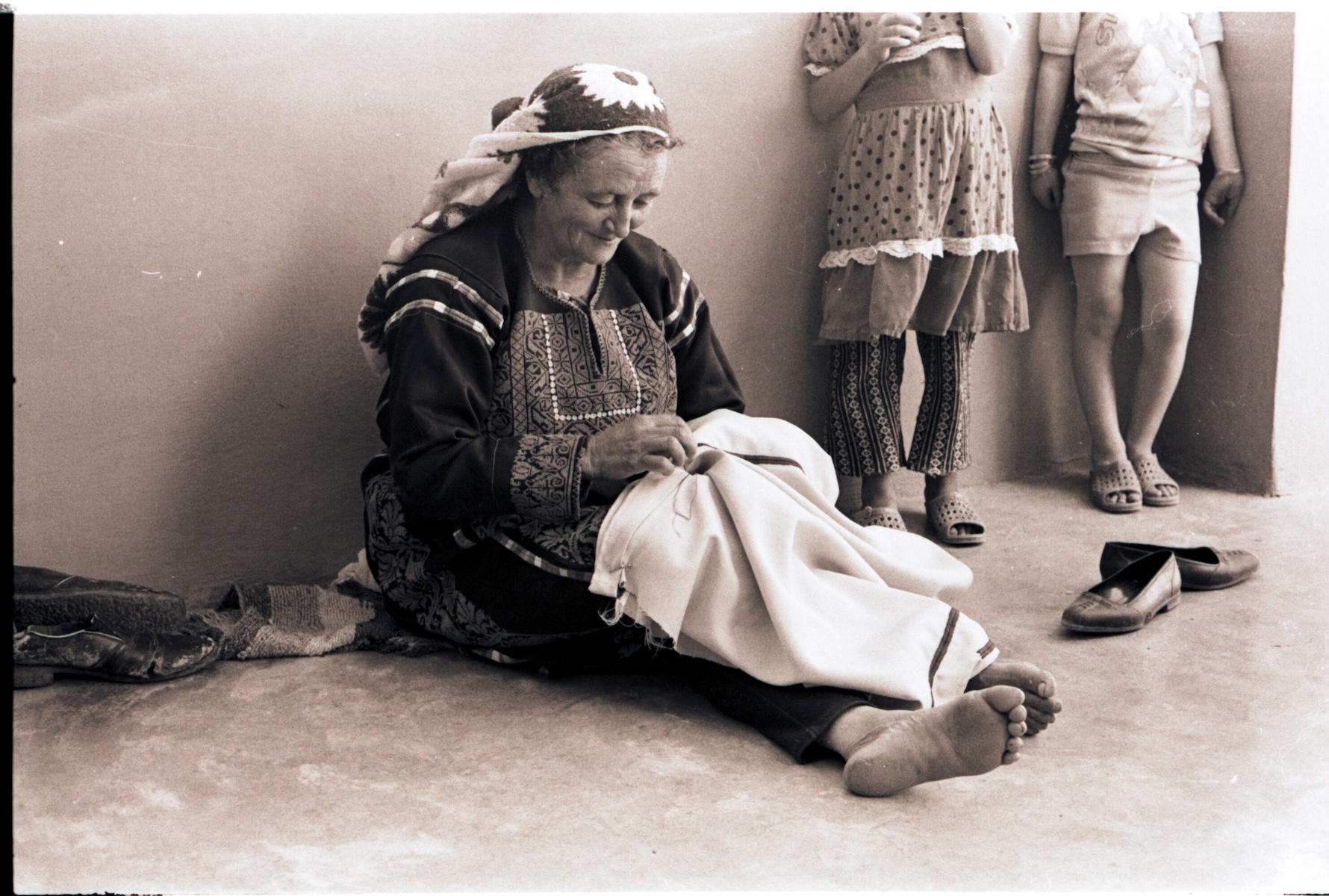
Fatima Yousef Sewing a Palestinian thobe, Kobar-Ramallah, the 1970s
What gives ‘Thread Memory’ its depth is its interweaving of past and present. Since October 2023, more than 50,000 Palestinians have been killed in Gaza, according to the Gaza Health Ministry. But beyond the unfathomable human cost, another slower, quieter violence, which persisted for decades, is brought to light. The exhibition pays homage to decades of solidarity work, including the 45-year twin city partnership between Dundee and Nablus in Palestine. Since 1980, when it was illegal to fly the Palestinian flag even in parts of the occupied territories of Palestine, Dundee raised it above its City Chambers. One room displays personal photo albums from these exchanges, documenting some of the many fire engines that Dundee has sent to Nablus. Visitors can also see a dress worn by Nadia El-Nakla, wife of Scottish First Minister Humza Yousaf, at his 2023 inauguration. The image went viral, as Dedman explains: ‘I remember seeing that moment and thinking how powerful it was: how a single dress can represent so much, and how the act of wearing it can resonate globally.’
‘Thread Memory’ is both archive and act of resistance. ‘I think here in the UK in particular, for those bearing witness to the suffering of Palestinians from very far away, and feeling helpless, watching that suffering, and watching the dehumanisation of Palestinian life in the media,’ Dedman says, ‘being able to read people’s names, to immerse yourself and celebrate Palestinian joy and creativity, while also acknowledging what’s happening now, has felt cathartic, beautiful and meaningful.’ In the face of a genocide, the show offers not a passive lament but a radical insistence: that Palestinian life, in all its colour, complexity, and creativity, will not be silenced by bombs or bulldozers. Because in thread, there is memory. And in memory, there is defiance.
‘Thread Memory: Embroidery from Palestine’ runs at V&A Dundee until Spring 2026.
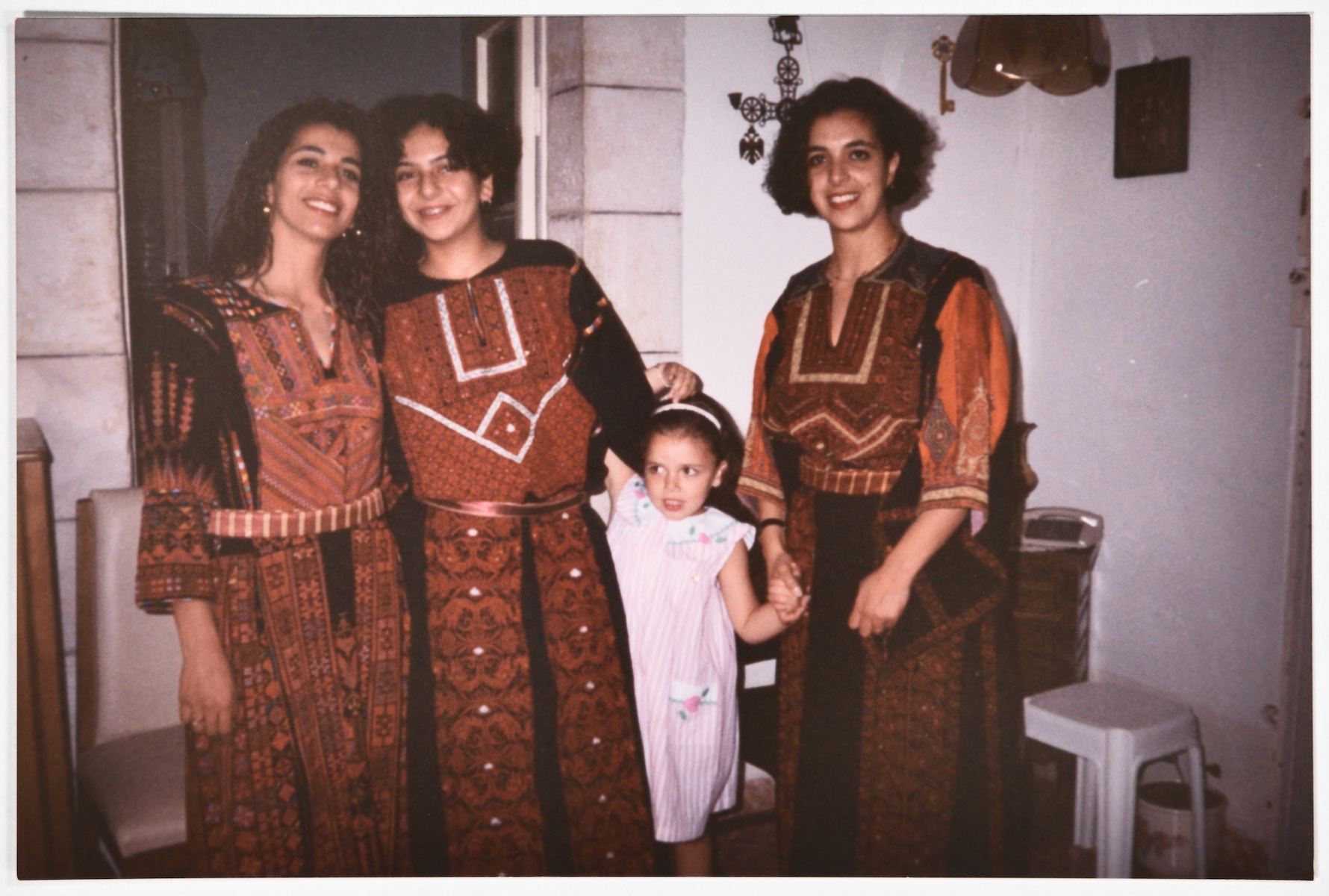
Sofia Hallström is a Sweden-born artist and culture writer who has contributed to publications including Frieze, AnOther and The Face, among others.
-
 Each mundane object tells a story at Pace’s tribute to the everyday
Each mundane object tells a story at Pace’s tribute to the everydayIn a group exhibition, ‘Monument to the Unimportant’, artists give the seemingly insignificant – from discarded clothes to weeds in cracks – a longer look
-
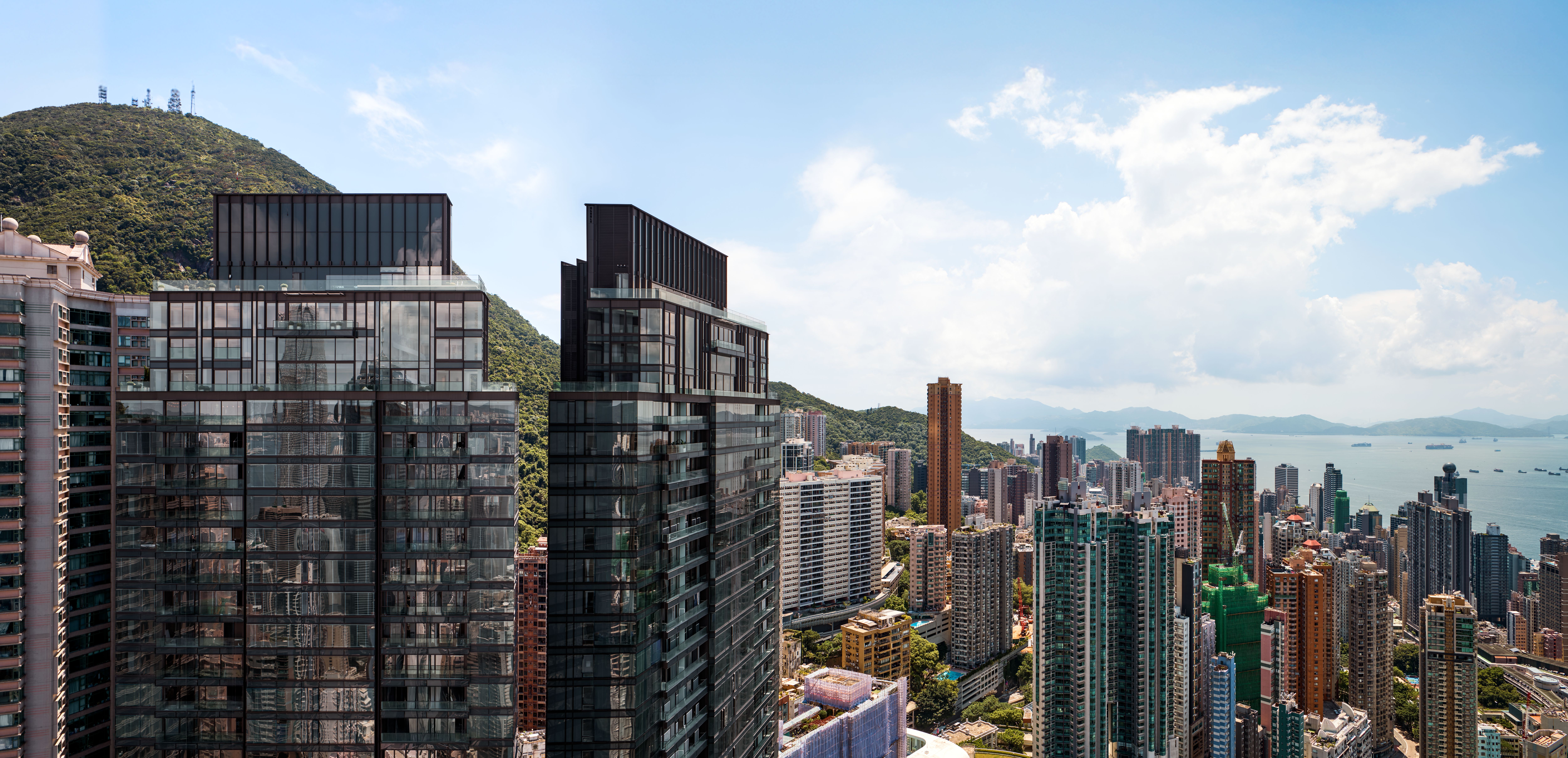 Discover The Legacy, Hong Kong’s eye-catching new condo
Discover The Legacy, Hong Kong’s eye-catching new condoThe Legacy, by ACPV Architects Antonio Citterio Patricia Viel, is a striking new condo tower that aims to ‘create a sense of community and solidarity among people’
-
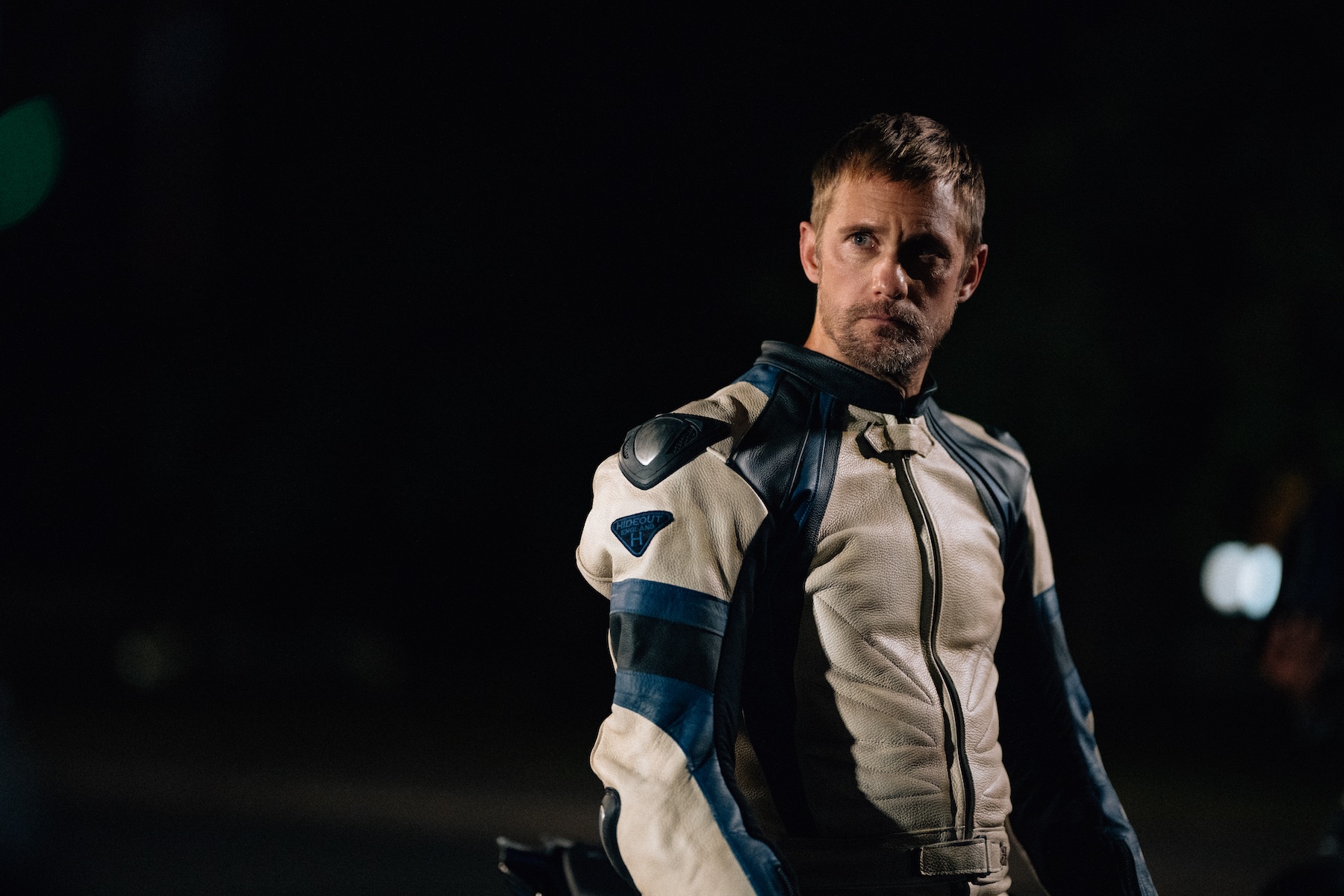 In BDSM biker romance ‘Pillion’, clothes become a medium for ‘fantasy and fetishism’
In BDSM biker romance ‘Pillion’, clothes become a medium for ‘fantasy and fetishism’Costume designer Grace Snell breaks down the leather-heavy wardrobe for the Alexander Skarsgård-starring Pillion, which traces a dom/sub relationship between a shy parking attendant and a biker
-
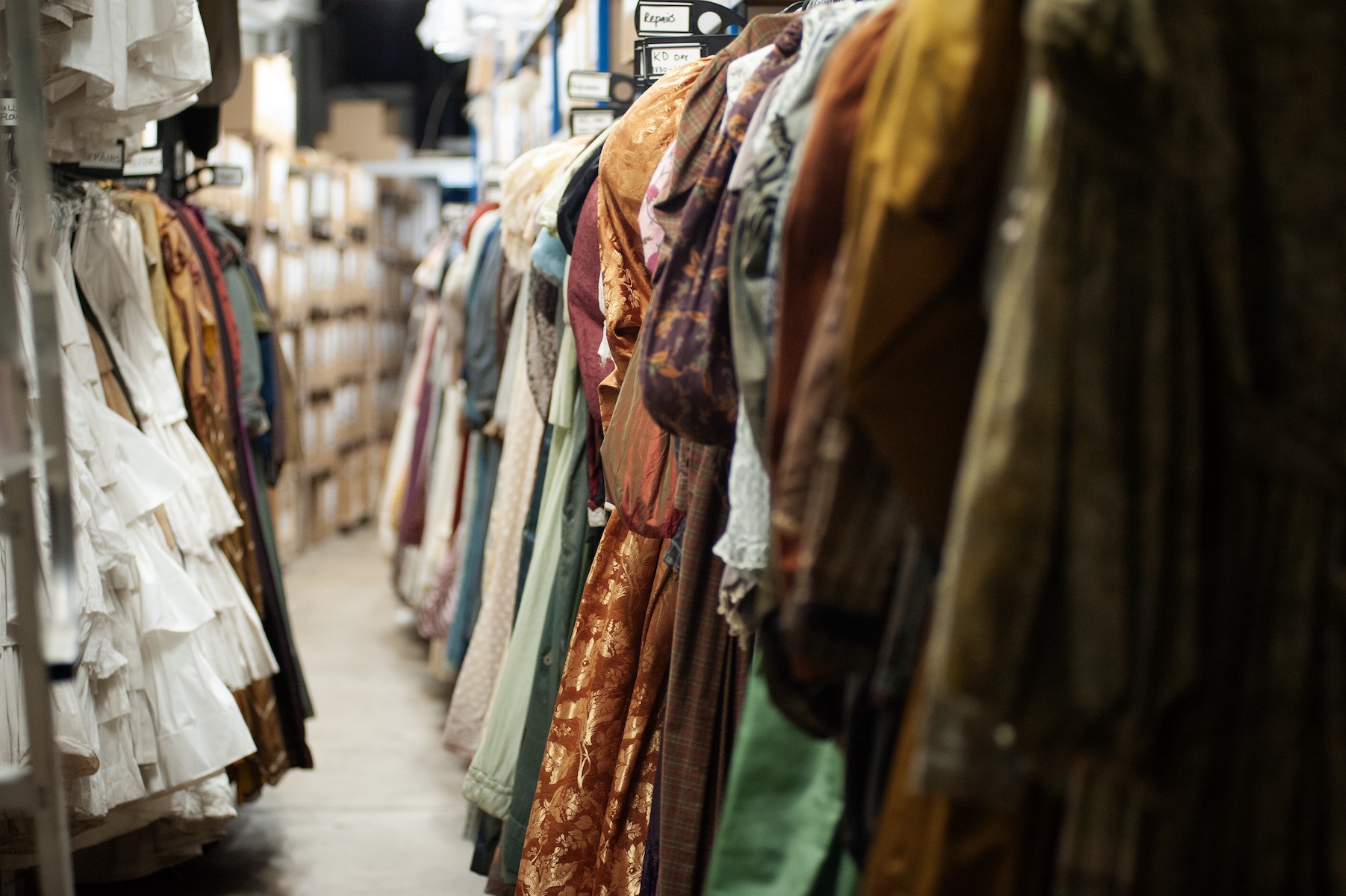 Inside Cosprop, the spectacular London costume house that’s a ‘dressing-up closet’ for stage and screen
Inside Cosprop, the spectacular London costume house that’s a ‘dressing-up closet’ for stage and screenAs a new exhibition, ‘Costume Couture: Sixty Years of Cosprop’, opens at London’s Fashion and Textile Museum, Wallpaper* tours the Holloway Road costume house that has outfitted the world’s biggest stars
-
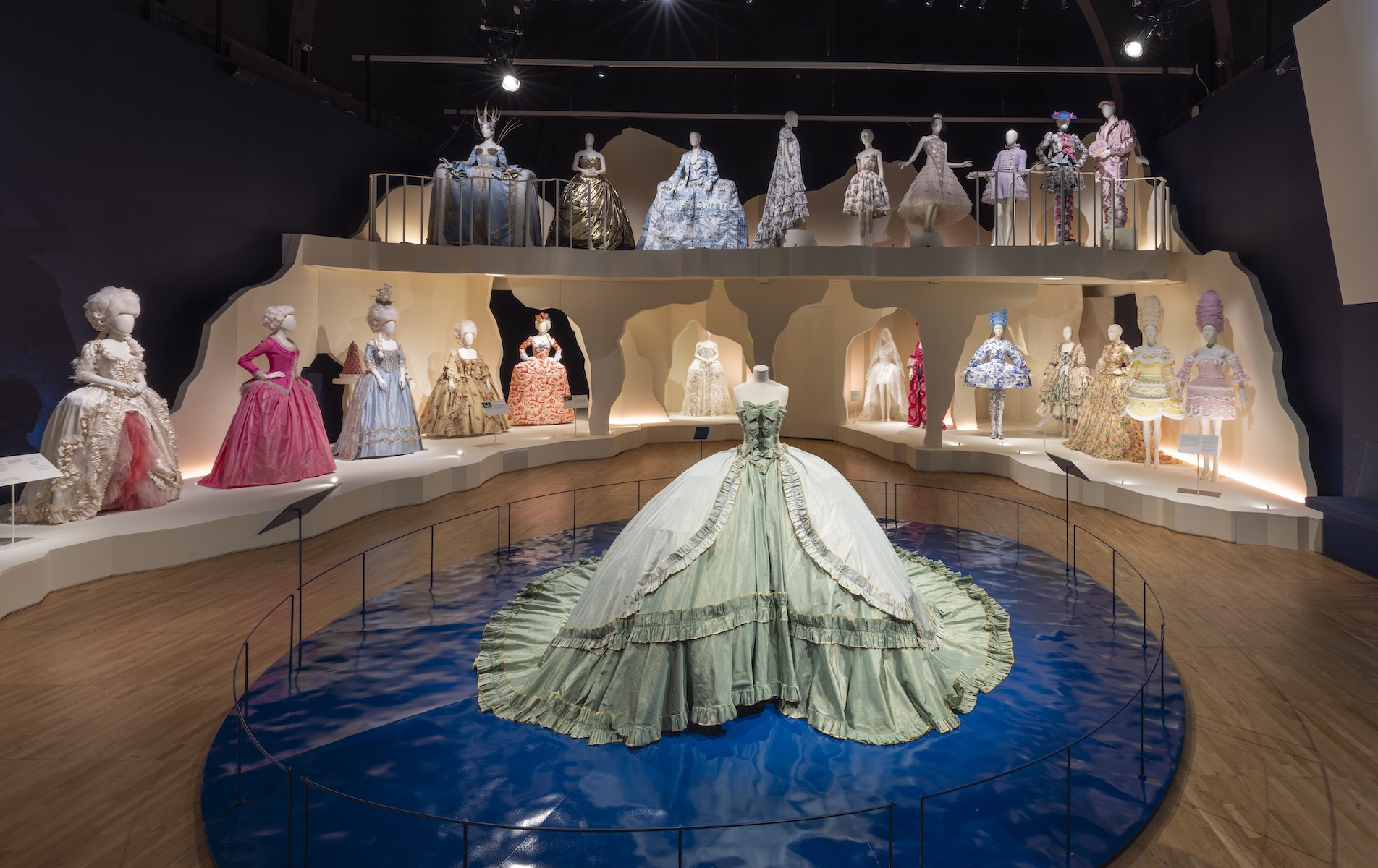 ‘Marie Antoinette Style’ at the V&A dares us to consider the woman beneath the artifice
‘Marie Antoinette Style’ at the V&A dares us to consider the woman beneath the artificeThe most intriguing objects in the V&A’s landmark exhibition on Marie Antoinette are not the sumptuous gowns or jewellery, but those which expose the French monarch’s corporality – from her spittoon to a toiletry case – argues India Birgitta Jarvis
-
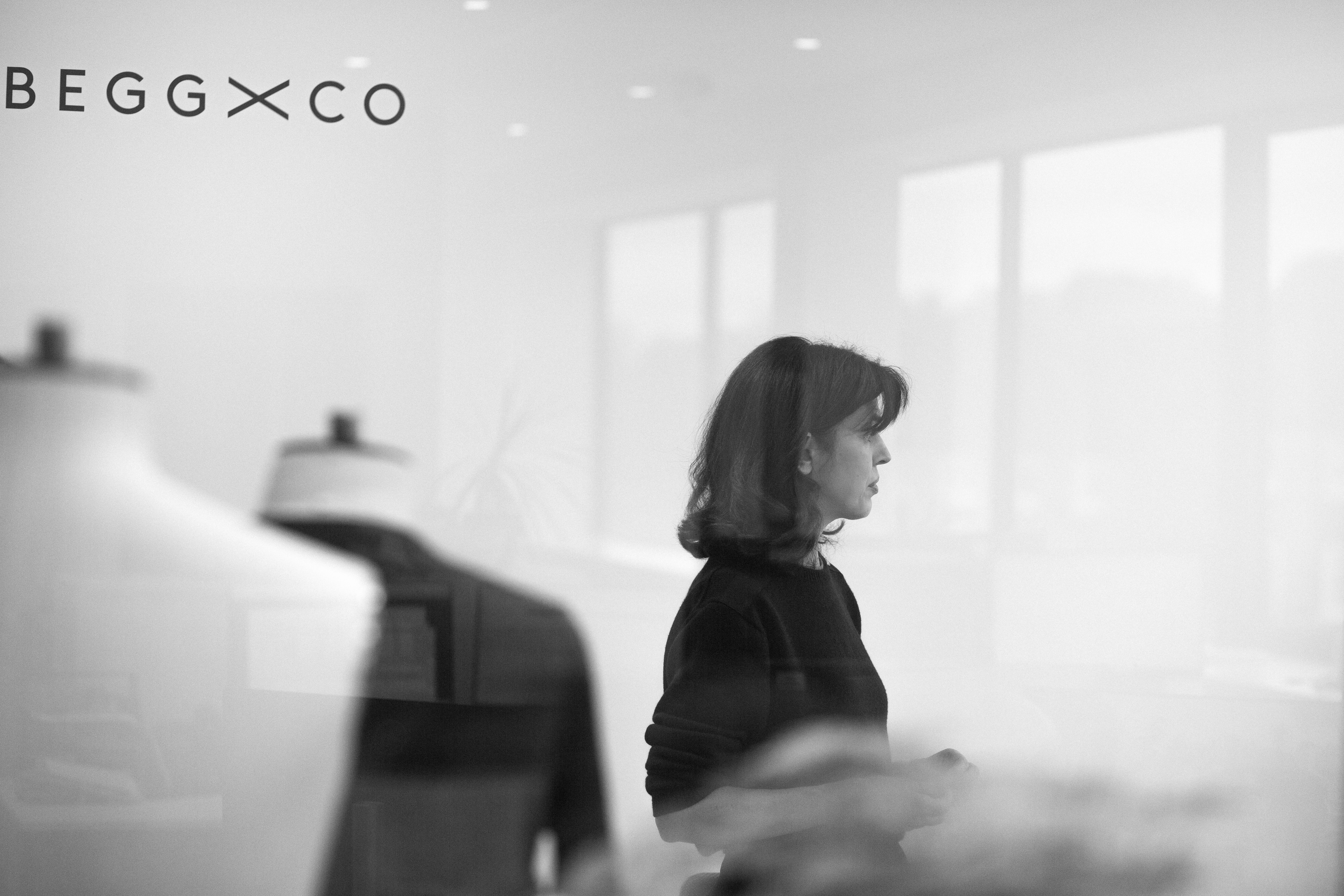 Vanessa Seward on her new vision for Begg x Co, the Scottish knitwear brand with over a century of history
Vanessa Seward on her new vision for Begg x Co, the Scottish knitwear brand with over a century of historyAs the new creative director of Begg x Co, Parisian designer Vanessa Seward wants to harness the ‘beauty and quality’ of its knits to make it ‘the go-to luxury brand for Scottish cashmere’
-
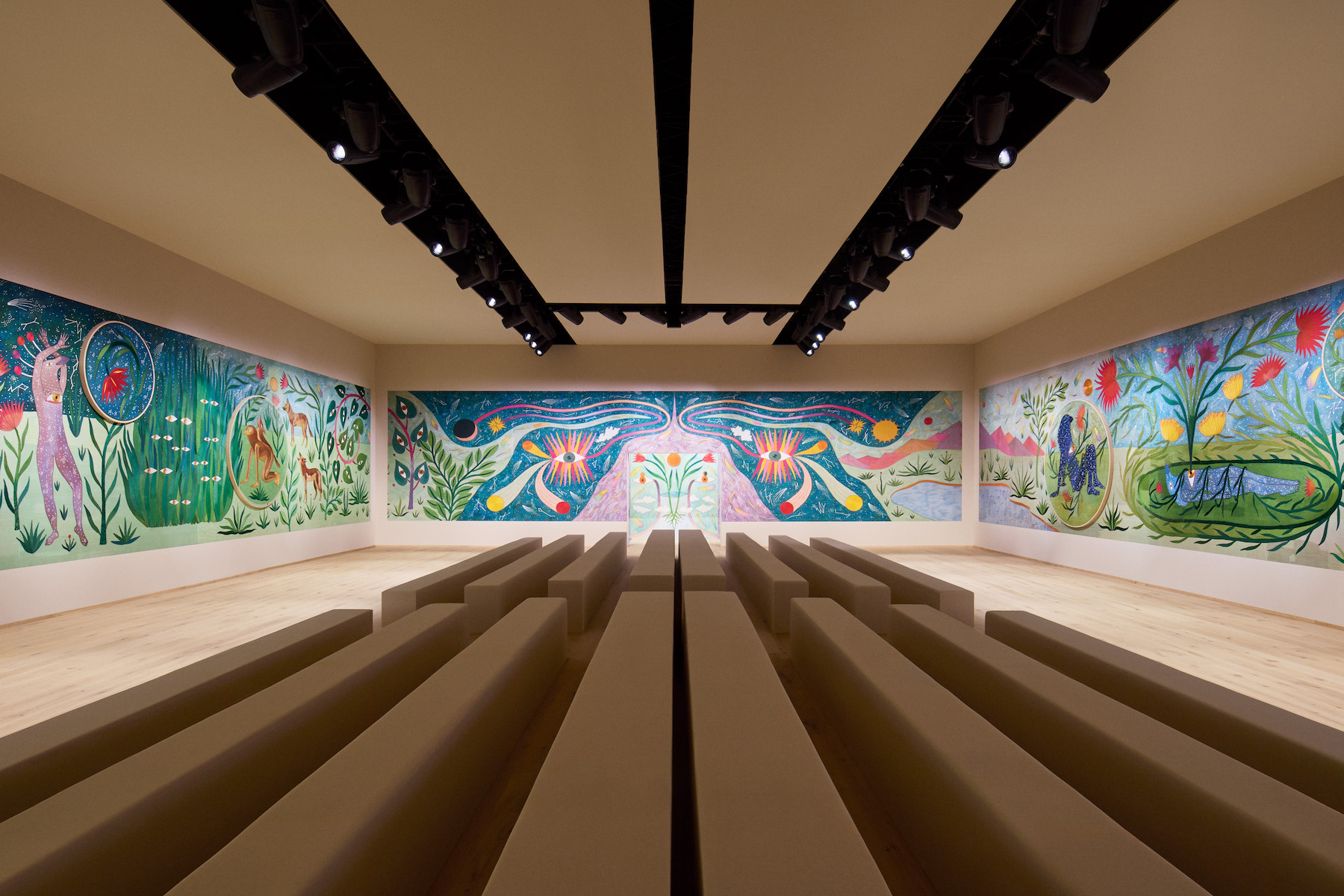 Indian artist Rithika Merchant on her fantastical show set for Dior couture: ‘It’s about building a wonderland’
Indian artist Rithika Merchant on her fantastical show set for Dior couture: ‘It’s about building a wonderland’Rithika Merchant tells Wallpaper* the story behind her immersive work ‘The Flowers We Grew’, which backdropped Maria Grazia Chiuri’s Alice in Wonderland-inspired S/S 2025 couture show in Paris yesterday (27 January 2025)